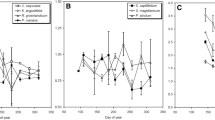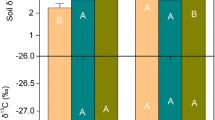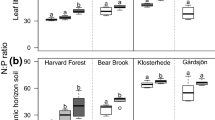Abstract
High-latitude peatlands are important soil carbon sinks. In these ecosystems, the mineralization of carbon and nitrogen are constrained by low temperatures and low nutrient concentrations in plant litter and soil organic matter. Global warming is predicted to increase soil N availability for plants at high-latitude sites. We applied N fertilizer as an experimental analogue for this increase. In a three-year field experiment we studied N fertilization effects on leaf litter decomposition and N dynamics of the four dominant plant species (comprising >75% of total aboveground biomass) in a sub-arctic bog in northern Sweden. The species were Empetrum nigrum (evergreen shrub), Eriophorum vaginatum (graminoid), Betula nana (deciduous shrub) and Rubus chamaemorus (perennial forb). In the controls, litter mass loss rates increased in the order: Empetrum < Eriophorum < Betula < Rubus. Increased N availability had variable, species-specific effects: litter mass loss rates (expressed per unit litter mass) increased in Empetrum, did not change in Eriophorum and Betula and decreased in Rubus. In the leaf litter from the controls, we measured no or only slight net N mineralization even after three years. In the N-fertilized treatments we found strong net N immobilization, especially in Eriophorum and Betula. This suggests that, probably owing to substantial chemical and/or microbial immobilization, additional N supply does not increase the rate of N cycling for at least the first three years.

Similar content being viewed by others
References
Aerts R (1997) Climate, leaf litter chemistry and leaf litter decomposition in terrestrial ecosystems: a triangular relationship. Oikos 79:439–449
Aerts R, Chapin FS (2000) The mineral nutrition of wild plants revisited: a re-evaluation of processes and patterns. Adv Ecol Res 30:1–67
Aerts R, De Caluwe H (1997) Nutritional and plant-mediated controls on leaf litter decomposition of Carex species. Ecology 78:244–260
Berg B, Matzner E (1996) Effect of N deposition on plant litter and soil organic matter in forest systems. Environmental Rev 5:1–25
Berg B, Berg MP, Bottner P et al. (1993) Litter mass loss rates in pine forests of Europe and Eastern United States: some relationships with climate and litter quality. Biogeochemistry 20:127–159
Cornelissen JHC (1996) An experimental comparison of leaf decomposition rates in a wide range of temperate plant species and types. J Ecol 84:573–582
Gorham E (1991) Northern peatlands: role in the carbon cycle and probable responses to climatic warming. Ecol Appl 1:182–195
Harborne JB (1997) Role of phenolic secondary metabolites in plants and their degradation in nature. In: Cadisch G, Giller KE (eds), Driven by nature: plant litter quality and decomposition. CAB International, Wallingford, pp 67–74
Hättenschwiler S, Vitousek PM (2000) The role of polyphenols in terrestrial ecosystem nutrient cycling. Trends Ecol Evol 15:238–243
Hobbie SE, Vitousek PM (2000) Nutrient limitation of decomposition in Hawaiian forests. Ecology 81:1867–1877
Houghton JT, Ding Y, Griggs DJ et al. (2001) Climate change 2001: the scientific basis third IPCC report. Cambridge University Press, Cambridge
Jonasson S, Michelsen M, Schmidt IK, Nielsen EV, Callaghan TV (1996) Microbial biomass C, N and P in two arctic soils and responses to addition of NPK fertilizer and sugar: implications for plant nutrient uptake. Oecologia 106:507–515
Köchy M, Wilson SD (1997) Litter decomposition and nitrogen dynamics in aspen forest and mixed-grass prairie. Ecology 78:732–739
Kögel-Knabner I (2002) The macromolecular organic composition of plant and microbial residues as inputs to soil organic matter. Soil Biol& Biochem34:139–162
Kraus TEC, Dahlgren RA, Zasoski RJ (2003) Tannins in nutrient dynamics of forest ecosystems–a review. Plant and Soil 256:41–66
Kraus TEC, Zasoski RJ, Dahlgren RA (2004) Fertility and pH effects on polyphenol and condensed tannin concentrations in foliage and roots. Plant and Soil 262:95–109
Melillo JM, Aber JD, Muratore JF (1982) Nitrogen and lignin control of hardwood leaf litter decomposition dynamics. Ecology 63:621–626
Palm CA, Rowland AP (1997) A minimum dataset for characterization of plant quality for decomposition. In: Cadisch G, Giller KE (eds), Driven by nature: plant litter quality and decomposition. CAB International, Wallingford, pp 379–392
Pastor J, Stillwell MA, Tilman D (1987) Little bluestem litter dynamics in Minnesota old fields. Oecologia 72:327–330
Poorter H, Villar R (1997) The fate of acquired carbon in plants: chemical composition and construction costs. In: Bazzaz FA, Grace J (eds), Plant resource allocation. Academic Press, San Diego, pp 39–72
Quested HM, Cornelissen JHC, Press MC et al. (2003) Litter decomposition of sub-arctic plant species with differing nitrogen economies: a potential functional role for hemiparasites. Ecology 84:3209–3221
Quinn GP, Keough MJ (2002) Experimental design and data analysis for biologists. Cambridge University Press, Cambridge
Robinson CH (2002) Controls on decomposition and soil nitrogen availability at high latitudes. Plant Soil 242:65–81
Robinson CH, Wookey PA, Parsons AN, Potter JA, Lee JA, Callaghan TV, Press MC, Welker JM (1995) Responses of plant litter decomposition and nitrogen mineralisation to simulated environmental change in a high arctic polar semi-desert and a subarctic dwarf shrub heath. Oikos 74:503–512
Rustad LE, Campbell JL, Marion GM et al (2001) A meta-analysis of the response of soil respiration, net nitrogen mineralization, and aboveground plant growth to experimental ecosystem warming. Oecologia 126:543–562
Schimel JP, Cates RG, Ruess R (1998) The role of balsam poplar secondary chemicals in controlling soil nutrient dynamics through succession in the Alaskan taiga. Biogeochemistry 42:221–234
Shaw MR, Harte J (2001) Control of litter decomposition in a subalpine meadow-sagebrush steppe ecotone under climate change. Ecol Appl 11:1206–1223
Sonesson M (1980) Ecology of a subarctic mire. Ecological Bulletins 30 (Stockholm).
Swift MJ, Heal OW, Anderson JM (1979). Decomposition in terrestrial ecosystems. University of California Press, Berkeley
Tietema A (1993) Mass loss and nitrogen dynamics in decomposing acid forest litter in the Netherlands at increased nitrogen deposition. Biogeochemistry 20:45–62
Vitousek PM, Turner DR, Parton WJ, Sanford RL (1994) Litter decomposition on the Mauna Loa environmental matrix, Hawaii: patterns, mechanisms, and models. Ecology 75:418–429
Acknowledgements
We gratefully acknowledge the director and staff of the Abisko Scientific Research Station for facilitating this study. Thanks are due to Ellen Dorrepaal who did part of the nutrient additions for us and whose critical comments greatly improved this paper. This study was financially supported by USF grant 98/24 to RA. The field experiment described in this paper complied with Swedish law.
Author information
Authors and Affiliations
Corresponding author
Additional information
Communicated by Christian Koerner
Rights and permissions
About this article
Cite this article
Aerts, R., Logtestijn, R.S.P.v. & Karlsson, P.S. Nitrogen supply differentially affects litter decomposition rates and nitrogen dynamics of sub-arctic bog species. Oecologia 146, 652–658 (2006). https://doi.org/10.1007/s00442-005-0247-5
Received:
Accepted:
Published:
Issue Date:
DOI: https://doi.org/10.1007/s00442-005-0247-5




